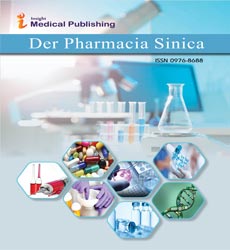ISSN : 0976 - 8688
Der Pharmacia Sinica
Various methods of Drug Elimination from Body
Mehnaz Kamal*
Department of Pharmaceutical Chemistry, Prince Sattam Bin Abdulaziz University, Al-Kharj, Saudi Arabia
- *Corresponding Author:
- Mehnaz Kamal
Department of Pharmaceutical Chemistry, Prince Sattam Bin Abdulaziz University, Al-Kharj, Saudi Arabia
E-mail: kamal.m@gmail.com
Received Date: November 02, 2021; Accepted Date: November 16, 2021; Published Date:November 23, 2021
Citation: Kamal M (2021) Various Methods of Drug Elimination from Body. Der Pharmacia Sinica, Vol.12 No. 6: 17.
Commentary
The kidney is the most important organ for excreting watersoluble substances. The biliary system contributes to excretion to the extent that the drug is not absorbed from the gastrointestinal tract (GI). In general, the contribution of the intestine, saliva, sweat, breast milk, and lungs to excretion is small, except for the exhalation of volatile anesthetics. Excretion in breast milk can affect lactating children. Liver metabolism often increases the polarity and water solubility of the drug. The resulting metabolites are more easily excreted. Renal filtration is responsible for the majority of drug excretion. About one-fifth of the plasma that reaches the glomerulus is filtered through the pores of the glomerular endothelium. Almost all water and most electrolytes are passively and actively reabsorbed from the renal tubules into the circulation. The polar compounds that make up most drug metabolites cannot diffuse back into the circulation and are excreted unless there is a specific transport mechanism for re absorption (eg glucose, ascorbic acid, B vitamins).
Renal excretion
Renal drug excretion decreases with age. By age 80, clearance is usually reduced to half that of age 30. Drug excretion in the kidneys can also change depending on various health conditions. In severely ill patients, kidney damage can temporarily reduce the excretion of drugs by the kidneys. In contrast, increased renal clearance (eg, young, severely ill patients with unimpaired renal function) increases renal drug excretion in children and children with plasma concentrations below the therapeutic dose of certain drugs, especially antibiotics. May bring to both the trans membrane principle regulates the handling of the drug in the kidney. Drugs bound to plasma proteins remain in the circulation. The glomerular filtrate contains only unbound drugs. The unified form of the drug and its metabolites tends to be easily absorbed from the tubular fluid.
Urine pH values vary between 4.5 and 8.0 because they determine the ionization status of weak acids or bases, so urine pH values can have a significant impact on drug absorption and excretion (passive diffusion). See). Urine acidification increases reabsorption, reduces weak acid excretion, and in contrast, reduces weak base reabsorption. Alkalinization of urine has the opposite effect. For some overdose, these principles are used to improve the removal of weak bases or weak acids. The extent to which changes in urine pH change the rate of drug excretion depends on the contribution of the renal pathway to complete excretion, the polarity of the non-ionized form, and the degree of ionization of the molecule.
Active tubular secretion in the proximal tubule is important for the removal of many drugs. This energy-dependent process can be blocked by metabolic inhibitors. With high concentrations of active substance, secretory transport can reach the upper limit. All substances have a characteristic maximum transport volume.
Anions and cations are processed by separate transport mechanisms. Normally, the anion secretion system eliminates metabolites bound to glycine, sulfate, or glucuronic acid. Anions compete with each other for secretion. This competition can be used therapeutically. For example, probenecid blocks the normally rapid tubular secretion of penicillin and prolongs the plasma concentration of penicillin. In the cation transport system, cations or organic bases (such as pramipexole and dofetilide) are secreted from the renal tubules. This process can be inhibited by cimetidine, trimethoprim, prochlorperazine, megestrol, or ketoconazole.
Biliary excretion
Most drugs and their metabolites are removed from bile. Active secretory transport is required as they are transported through the bile epithelium against concentration gradients. If the drug concentration in plasma is high, secretory transport may approach the upper limit (maximum transport). Substances with similar physicochemical properties can compete for excretion. Drugs with a molecular weight of more than ˃300 g / mol and both polar and lipophilic groups are more likely to be excreted in the bile. Smaller molecules are generally excreted in very small amounts. In particular, conjugation with glucuronic acid promotes excretion in bile. In entero hepatic circulation, the active ingredient excreted in bile is absorbed from the intestine into the circulatory system. Bile excretion eliminates substances from the body only to the extent that entero hepatic circulation is incomplete-if some of the secreted drug is not absorbed from the intestine.
Open Access Journals
- Aquaculture & Veterinary Science
- Chemistry & Chemical Sciences
- Clinical Sciences
- Engineering
- General Science
- Genetics & Molecular Biology
- Health Care & Nursing
- Immunology & Microbiology
- Materials Science
- Mathematics & Physics
- Medical Sciences
- Neurology & Psychiatry
- Oncology & Cancer Science
- Pharmaceutical Sciences
